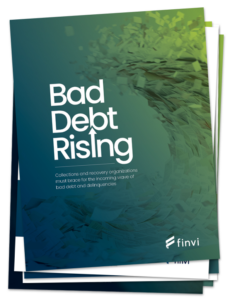Blog & Insights
Manage Increasing Delinquencies with Omnichannel Communication

It’s no secret that the amount of consumer debt continues to rise. Quite often, this leads to an increase in delinquencies and unpaid accounts. That means an increase in the amount of work for collections and recovery agencies. More work increases the chances of errors being introduced into the process. Of course, increasing the number of staff would be helpful, but in the current landscape, adding headcount isn’t likely.
With this influx of delinquencies on the horizon, and no additional employees walking through the door, collections and recovery agencies need a way to make their employees more efficient. This would help take some of the burden off an already overworked staff.
Implementing an omnichannel communication platform is a good start.
Rising debt and delinquencies
Many U.S. citizens are still struggling with debt. So much so that total consumer debt in the U.S. grew to a staggering $17 trillion in the first quarter of 2023. Some of this debt was a direct outcome of the global pandemic, which resulted in many businesses laying off employees or closing permanently. Struggling citizens had little choice but to turn to credit cards and personal loans to make ends meet.
Yet, credit card debt is still rising. Credit card balances have increased by $45 billion, from $986 billion in the first quarter of 2023 to a high of $1.03 trillion in the second quarter of 2023. That equates to a 4.6% quarterly increase.
As anticipated, this increasing debt has led to a rise in delinquencies. The rate of new credit card delinquencies has surpassed its pre-COVID level, reaching 7.2% in the second quarter of 2023.
Embrace technology
With this increase in delinquencies, collections and recovery organizations will soon find themselves with a growing number of accounts to manage. Yet, these teams are already hampered by workforce shortages and overworked staffs, which might not be ready to handle an influx of new accounts. However, technology can help.
Technology continues to change the way individuals and organizations go about their daily work. And collections and recovery organizations must keep flexibility in mind, quickly embracing new technology to adapt to changes in industry.
That’s why organizations should adopt a collections platform that can develop and manage a true omnichannel communication strategy.
Which channel?
We’re in the era of digital communication, and it’s imperative that collections and recovery agencies use these new channels to their advantage. However, that means more than just sending an email. While this used to be the most innovative and popular way to reach out to customers just a few years ago, that is no longer the case today. Texting has become the communication channel of choice. And the data to support this is almost overwhelming. Just a small sample includes:
- More than 95% of text messages are read and responded to within 3 minutes of being received.
- The average open rate for an SMS campaign is 98%, five-times that of email.
- The average SMS response time is 3 minutes, while it is 90 minutes for email.
- Nearly 48% of customers prefer communication from businesses to come from text messages.
- About 61% of consumers want the ability to two-way text with a business.
- Only 3% of SMS messages are considered spam, compared to nearly 85% of emails.
Clearly, text messaging has become quite popular. Yet, other channels still play an important role in today’s digital era. A recent survey of U.S. consumers showed that:
- 50% of respondents prefer to receive payment reminders via email.
- 40% of respondents prefer to receive bills/statements via email.
What this data shows is that people are different and have different preferences. So, a one-size-fits-all approach to reaching out to customers isn’t effective.
An omnichannel approach
An innovative software platform that enables agents to develop and manage a complete omnichannel communication strategy can increase employee efficiency and boost collections.
Organizations can create communication programs with activity across all channels – phone, traditional mail, email and text.
It starts with analyzing data about the customers, including their preferred method of payment, the likelihood of paying, and the best ways and times to communicate. This data is then used to develop comprehensive strategies designed to meet specific customer preferences. These strategies can then be tested prior to launching to measure their potential effectiveness. And we know how important it is to test strategies.
Organizations can even create individual strategies for different customer behaviors. For example, if you have a customer that chronically pays late, agents can create a strategy that includes additional reminders or reminders from multiple channels. Or if you have a customer that has never paid late, then is suddenly late with a payment, the communication strategy can be configured to automatically send a reminder.
In addition, tasks that were previously handled manually by agents can now be automated. Activities, such as reminders about payment schedules or due dates, can be scheduled and sent via the customer’s preferred channel. This leaves staff to focus on tasks and accounts that require a more human touch.
Omnichannel communication: A path to success
“Communication is your ticket to success if you pay attention and learn to do it effectively.”
This quote by author Theo Gold is increasingly becoming true for collections and recovery agencies. As delinquencies continue to rise and agencies become busier than ever, efficient and effective communication strategies will be paramount to success. And technology will play a key role in this. An innovative platform that allows for omnichannel communication can automate several tasks, taking some burden off your overworked employees.
It’s a clear path to success.

Want to learn more?
Read this eBook, which explains why collections and recovery organizations must invest in advanced technology solutions that are powerful enough to handle this sudden increase in collection activity and flexible enough to adjust to continuing economic uncertainty.
Disclaimer: Finvi is a technology company and provides this post solely for general informational and marketing purposes. You should not rely on the content of this material for any other purpose or as specific guidance for your company. Finvi’s advice, services, tools and products described herein do not guarantee compliance with any law or industry standard. You are ultimately responsible for your own company’s actions and compliance efforts. Because everyone’s situation is different, you must consult your own attorneys, accountants, and/or other advisors to obtain specific advice on your company’s compliance, legal, tax, regulatory and/or other business needs. Despite Finvi’s efforts to provide current and up-to-date information, you need to recognize that the information contained herein may become outdated quickly and may contain errors and/or other inaccuracies.
© 2023 Finvi. All rights reserved. Information contained in this document is subject to change. Reproduction of this publication is not permitted without the express permission of Finvi.

